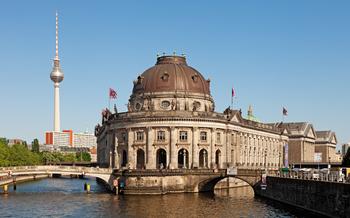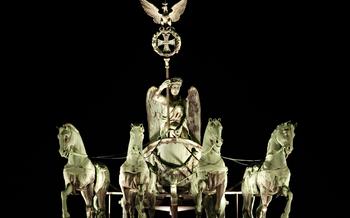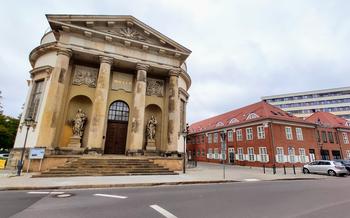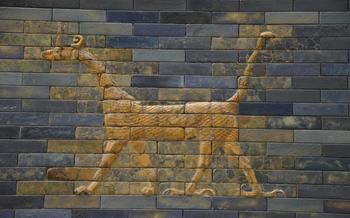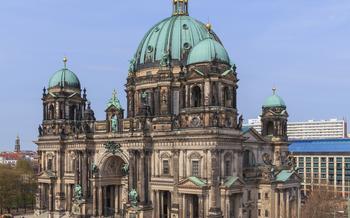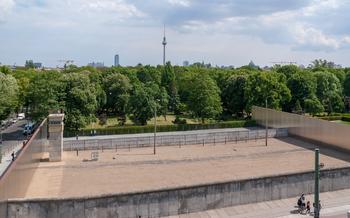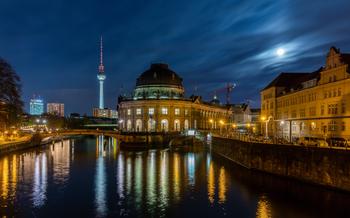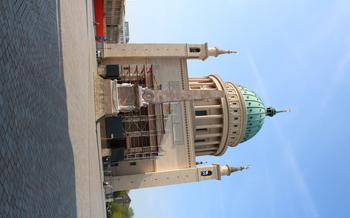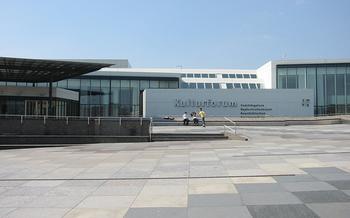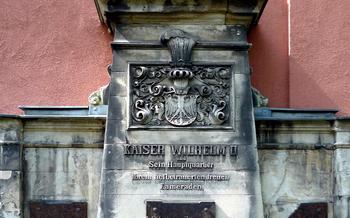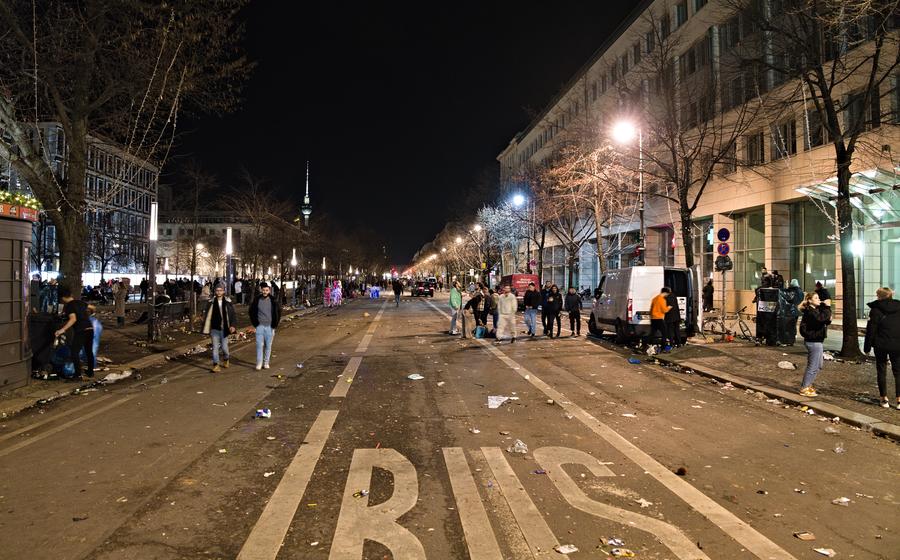
Unter den Linden
- Brandenburg Gate: A Symbol of Unity
- Pariser Platz: A Square of Elegance
- Hotel Adlon Kempinski: A Luxurious Landmark
- Neue Wache: A Memorial to the Fallen
- Deutsches Historisches Museum: A Journey Through German History
- Berliner Dom: A Majestic Cathedral
- Lustgarten: A Park with a Rich Past
- Altes Museum: A Treasure Trove of Antiquities
- Museum's Collections
- Architectural Features
- Notable Artifacts
- Personal Discoveries
- Neues Museum: A Showcase of Ancient Civilizations
- Pergamonmuseum: A World-Class Museum of Ancient Art
- Bode-Museum: A Haven for Art and Sculpture
- Staatsoper Unter den Linden: A Prestigious Opera House
- Humboldt Forum: A Center for Cultural Exchange
- Insider Tip: Explore the Courtyards of the Museumsinsel
Brandenburg Gate: A Symbol of Unity
The Brandenburg Gate stands as a majestic symbol of Berlin's tumultuous history and the resilience of the German people. Erected in the late 18th century, this neoclassical masterpiece was designed by Carl Gotthard Langhans and commissioned by King Frederick William II to commemorate Prussia's victory in the Napoleonic Wars. Its imposing Doric columns and intricate sculptures, including the iconic Quadriga atop the gate, have become synonymous with Berlin and Germany as a whole.
Throughout its existence, the Brandenburg Gate has witnessed countless historical events, from its original dedication to Prussia's military prowess to its role as a symbol of German reunification in 198During the Cold War, the gate stood as a physical barrier separating East and West Berlin, a poignant reminder of the division of the city and the country. Its reopening in 1989, with thousands of jubilant Berliners streaming through its archways, became a defining moment in German history, symbolizing the end of the Cold War and the beginning of a new era of unity and freedom.
The Quadriga, a magnificent sculpture of a chariot drawn by four horses, crowns the Brandenburg Gate and is one of its most distinctive features. Created by Johann Gottfried Schadow, the Quadriga originally depicted the Greek goddess Eirene, symbolizing peace. However, during Napoleon's occupation of Berlin in 1806, the Quadriga was taken to Paris as a war trophy. After Prussia's victory in the Napoleonic Wars, the Quadriga was returned to Berlin, but with a significant change: Eirene was replaced by the goddess Victoria, representing victory. This symbolic transformation reflected Prussia's triumph over Napoleon and its renewed sense of national pride.
Today, the Brandenburg Gate remains a powerful symbol of German unity and a popular tourist attraction. Visitors from around the world come to marvel at its architectural grandeur and to witness firsthand the historical significance of this iconic landmark. Whether admiring its intricate carvings, standing beneath its imposing archways, or simply basking in its symbolic presence, the Brandenburg Gate is an unforgettable experience that leaves a lasting impression on every visitor.
Pariser Platz: A Square of Elegance
Pariser Platz holds a significant place in Berlin's history and urban landscape. It was designed in the 17th century and served as a parade ground for Prussian troops. Today, it exudes an aura of elegance with its stately buildings, including the iconic Brandenburg Gate.
The square's architectural ensemble is a testament to Berlin's rich history. The Brandenburg Gate stands tall as a symbol of German reunification, with the Pariser Tor, the former city gate, adding a touch of historical charm. The Akademie der Künste, with its classical facade, houses exhibitions showcasing contemporary art and cultural events.
Amidst this architectural splendor, the Holocaust Memorial, a poignant reminder of the atrocities of the past, stands as a place for reflection and remembrance. The field of stelae, designed by architect Peter Eisenman, creates a powerful and moving experience for visitors.
In the heart of Pariser Platz, you can pause and admire the elegant Hotel Adlon Kempinski, a symbol of luxury and hospitality. Its grand facade and rich history make it a captivating sight.
As you stroll through Pariser Platz, take a moment to soak in the atmosphere of this historic square. Reflect on the events that have unfolded here, marvel at the architectural wonders, and pay your respects at the Holocaust Memorial. Pariser Platz is a place where history, culture, and remembrance converge, making it a must-visit destination in Berlin.
Hotel Adlon Kempinski: A Luxurious Landmark
The Hotel Adlon Kempinski, situated on Unter den Linden, stands as a testament to Berlin's rich history and remarkable resilience. Originally built in 1907, the hotel quickly gained a reputation for its grandeur and elegance, attracting a clientele of royalty, celebrities, and prominent figures from around the world.
During World War II, the hotel suffered extensive damage from Allied bombings, leaving only a charred shell. However, in 1997, it underwent a meticulous reconstruction, restoring it to its former glory. Today, the Hotel Adlon Kempinski once again welcomes guests with its opulent lobby, adorned with marble columns, crystal chandeliers, and intricate tapestries.
Over the years, the hotel has played host to countless notable personalities, including Charlie Chaplin, Albert Einstein, and Marlene Dietrich. It has also been featured in numerous films and television shows, further cementing its status as a Berlin icon.
During my stay at the Hotel Adlon Kempinski, I had the opportunity to experience its unparalleled luxury firsthand. From the moment I stepped through the grand entrance, I was greeted with impeccable service and warm hospitality. My room was spacious and elegantly appointed, offering stunning views of the Brandenburg Gate.
One evening, I dined at the hotel's renowned restaurant, Lorenz Adlon Esszimmer, where I savored a delectable tasting menu paired with exquisite wines. The culinary journey was truly exceptional, showcasing the talents of the hotel's award-winning chefs.
The Hotel Adlon Kempinski is more than just a hotel; it is a symbol of Berlin's enduring spirit. Its rich history, luxurious accommodations, and exceptional service make it a truly unforgettable destination for travelers seeking an extraordinary experience.
Neue Wache: A Memorial to the Fallen
With its somber façade and poignant history, the Neue Wache stands as a testament to the sacrifices made by German soldiers throughout the nation's tumultuous past. Initially commissioned by King Frederick the Great as a guardhouse, the building underwent a profound transformation after World War I, becoming a memorial to the fallen soldiers of all German wars.
Architect Heinrich Tessenow's redesign in 1931 imbued the Neue Wache with a stark simplicity that amplifies its commemorative purpose. The building's exterior, devoid of ornamentation, exudes a sense of quiet dignity, while the interior features a central sculpture that evokes a profound sense of loss and remembrance.
Käthe Kollwitz's poignant sculpture, "Mother with her Dead Son," occupies the heart of the Neue Wache. Created in 1937, the sculpture portrays a grieving mother cradling her lifeless son, symbolizing the immeasurable suffering caused by war. The raw emotional power of Kollwitz's work invites visitors to contemplate the human cost of conflict and to honor the memory of those who have fallen.
My visit to the Neue Wache was a deeply moving experience. The serene atmosphere, coupled with the emotional intensity of Kollwitz's sculpture, created a profound sense of contemplation and remembrance. As I stood in the hushed silence of the memorial, I couldn't help but feel a deep sense of empathy for the countless lives lost in war.
The Neue Wache serves as a powerful reminder of the devastating impact of war and the importance of striving for peace. It is a place where visitors can come to pay their respects, reflect on the horrors of conflict, and recommit themselves to the pursuit of a more peaceful world.
Deutsches Historisches Museum: A Journey Through German History
The Deutsches Historisches Museum, situated at the heart of Unter den Linden, is a captivating institution that invites visitors to embark on a journey through the rich tapestry of German history. Spanning two millennia, the museum's extensive collections, permanent and temporary exhibits, and interactive displays provide a comprehensive and immersive experience.
The museum's collections encompass an array of artifacts, documents, and artworks that chronicle Germany's political, social, economic, and cultural evolution. From medieval manuscripts to modern-day installations, the exhibits showcase the nation's triumphs and tribulations, its periods of prosperity and adversity.
Among the museum's highlights are the Imperial Regalia of the Holy Roman Empire, a collection of awe-inspiring artifacts that symbolize the power and prestige of Germany's former rulers. The museum also houses a substantial collection of paintings, sculptures, and decorative arts that offer a glimpse into the artistic achievements of German masters throughout the ages.
Interactive displays and multimedia presentations enhance the museum experience, allowing visitors to engage with history in a dynamic and engaging way. Whether it's exploring the intricacies of the German constitution or delving into the lives of influential historical figures, the Deutsches Historisches Museum offers a profound and thought-provoking journey through Germany's past.
Berliner Dom: A Majestic Cathedral
The Berliner Dom, also known as the Berlin Cathedral, stands as a magnificent testament to the city's rich history and architectural prowess. Completed in 1905, this neo-Renaissance masterpiece dominates the skyline of the Museum Island with its imposing dome and intricate facade.
The Berliner Dom's architectural grandeur is evident in every detail. Its massive dome, adorned with intricate mosaics and sculptures, soars above the city, evoking a sense of awe and wonder. The elaborate facade, featuring grand columns, arched windows, and intricate carvings, showcases the skill and artistry of the era's master builders.
The interior of the Berliner Dom is equally impressive, boasting a harmonious blend of grandeur and serenity. The vast nave, with its soaring vaults and elegant chandeliers, creates a sense of awe and reverence. The intricate stained-glass windows, depicting biblical scenes and historical figures, cast a colorful glow, adding to the cathedral's ethereal atmosphere.
The Berliner Dom is not just an architectural marvel but also a significant historical landmark. It has witnessed numerous pivotal events throughout Berlin's history, including imperial coronations, state ceremonies, and religious services. The cathedral's crypts serve as the resting place for members of the Hohenzollern dynasty, who ruled Prussia and Germany for centuries.
During my visit to the Berliner Dom, I was struck by its sheer size and grandeur. The intricate details of the facade, the soaring vaults of the nave, and the exquisite stained-glass windows left me in awe. I spent a considerable time exploring the cathedral, admiring its architectural features and learning about its historical significance. The Berliner Dom truly embodies the essence of Berlin's rich cultural heritage and is a must-visit attraction for anyone interested in history, architecture, and spirituality.
Lustgarten: A Park with a Rich Past
Nestled between the majestic Berliner Dom and the imposing Altes Museum, the Lustgarten, meaning "pleasure garden" in German, offers a tranquil oasis amidst the bustling streets of Berlin. Its history is as rich and varied as the city itself, dating back to the 16th century when it served as a hunting ground for the Electors of Brandenburg. In the 17th century, it was transformed into a Baroque-style garden adorned with fountains, sculptures, and exotic plants.
During the 19th century, the Lustgarten underwent significant changes, reflecting the evolving tastes and aspirations of the city. The Baroque elements were gradually replaced with Neoclassical features, and the park was redesigned to create a more open and spacious layout. In 1848, the equestrian statue of Frederick the Great was erected in the center of the park, becoming one of its most iconic landmarks.
The Lustgarten has witnessed many pivotal moments in German history. It was here that mass demonstrations and rallies took place during the tumultuous years of the German Revolution in 184In 1933, the Nazis staged a massive book burning in the park, targeting works by Jewish authors and other deemed subversive.
Today, the Lustgarten has been lovingly restored to its former glory and serves as a popular gathering place for Berliners and tourists alike. Its well-maintained lawns, vibrant flowerbeds, and shady trees provide a welcome respite from the hustle and bustle of the city. Visitors can stroll along the paths, admire the impressive architecture that surrounds the park, or simply relax on a bench and soak in the tranquil atmosphere.
One of my favorite personal moments in the Lustgarten was during a summer evening when I stumbled upon a group of musicians performing classical music under the trees. The melodious sounds filled the air, creating a magical ambiance that transported me back in time. It was a moment of pure bliss and a reminder of the rich cultural heritage that Berlin holds within its historic spaces.
Altes Museum: A Treasure Trove of Antiquities
The Altes Museum, a striking neoclassical edifice, stands as a testament to the rich cultural heritage of Germany. Completed in 1830, this architectural masterpiece was designed by renowned architect Karl Friedrich Schinkel and served as the first public museum in Berlin. Its grand facade, adorned with intricate sculptures and reliefs, offers a glimpse into the treasures that lie within.
Museum's Collections
The Altes Museum houses an extensive collection of ancient artifacts, spanning from prehistoric times to the Roman Empire. Among its highlights are the renowned Berlin Gold Hat, an enigmatic artifact crafted from thin gold sheets and adorned with intricate symbols, and the exquisite Greek vases, which showcase the artistry and craftsmanship of ancient Greek potters.
Architectural Features
Beyond its impressive collections, the Altes Museum is also a marvel of architecture. Schinkel's neoclassical design is evident in the building's symmetrical layout, Doric columns, and triangular pediment. The grand staircase, adorned with statues representing the gods of Mount Olympus, leads visitors to the museum's upper galleries, where the treasures of antiquity await.
Notable Artifacts
One of the most captivating exhibits at the Altes Museum is the Etruscan Hall, which houses a remarkable collection of artifacts from the ancient Etruscan civilization. The hall features an array of bronze sculptures, pottery, and jewelry, offering insights into the daily lives and religious practices of this enigmatic people.
Personal Discoveries
My visit to the Altes Museum was a journey through time, where I encountered the wonders of ancient civilizations. As I strolled through the galleries, I marveled at the intricate details of the artifacts, each piece telling a story of a bygone era. The museum's collection left an indelible mark on me, sparking a deep appreciation for the rich cultural heritage of humanity.
Neues Museum: A Showcase of Ancient Civilizations
At the northern end of the Museumsinsel, you'll find the Neues Museum, a striking testament to the Prussian passion for collecting and preserving ancient artifacts. Originally built in the mid-19th century, the museum suffered extensive damage during World War II and stood in ruins for decades. Its meticulous reconstruction, completed in 2009, has resulted in a stunning blend of old and new, where modern architecture harmoniously complements the original Neoclassical facade.
Inside, the Neues Museum is a treasure trove of ancient wonders from around the world. The Egyptian collection is particularly impressive, featuring artifacts from the Old, Middle, and New Kingdoms, including the famous bust of Queen Nefertiti, a masterpiece of ancient sculpture that will leave you breathless. The museum also houses significant collections of prehistoric artifacts, Greek and Roman sculptures, and gold jewelry from the Bronze Age.
One of the highlights of the Neues Museum is the stunning collection of artifacts from the ancient city of Troy, unearthed by German archaeologist Heinrich Schliemann in the late 19th century. Among these treasures are the "Priam's Treasure," a hoard of gold and silver objects believed to have belonged to the legendary Trojan king, and the "Zeus Altar," an intricately carved stone altar that offers a glimpse into the religious beliefs of the ancient Trojans.
My personal experience at the Neues Museum was nothing short of awe-inspiring. As I wandered through the galleries, I felt transported back in time, surrounded by the remnants of ancient civilizations. The sheer beauty and craftsmanship of the artifacts left me humbled and amazed. Whether you're a history buff, an art enthusiast, or simply someone who appreciates the wonders of the ancient world, the Neues Museum is a must-visit destination in Berlin.
Pergamonmuseum: A World-Class Museum of Ancient Art
The Pergamonmuseum, a UNESCO World Heritage Site, is the crown jewel of Museum Island. Its collection of ancient artifacts, spanning from the Near East to the Islamic world, is simply breathtaking. The museum's most famous exhibits include the monumental Pergamon Altar, the Market Gate of Miletus, and the Ishtar Gate of Babylon.
The Pergamon Altar, built in the 2nd century BC, is a masterpiece of Hellenistic art. Its intricate reliefs depict the battle between the gods and the giants, a mythical struggle that symbolizes the triumph of civilization over chaos. The Market Gate of Miletus, from the 2nd century AD, is an impressive example of Roman architecture. Its towering columns and intricate carvings offer a glimpse into the grandeur of the ancient Roman Empire.
The Ishtar Gate, one of the eight gates of the ancient city of Babylon, is a testament to the ingenuity and artistry of the Mesopotamians. Its glazed bricks, decorated with vibrant blue and yellow lions, depict the Babylonian goddess Ishtar. These colossal artifacts, meticulously excavated and reconstructed, transport visitors back in time, offering a glimpse into the grandeur and artistry of ancient civilizations.
The Pergamonmuseum isn't just about artifacts; its architecture is equally impressive. Designed by Alfred Messel and Ludwig Hoffmann, the museum's grand neoclassical facade and soaring atrium create a sense of awe and grandeur. The museum's spacious galleries and well-curated exhibits allow visitors to fully appreciate the beauty and significance of the ancient artifacts.
Whether you're an art enthusiast, a history buff, or simply someone who appreciates the wonders of human ingenuity, the Pergamonmuseum is an absolute must-visit. Its collection of ancient treasures, coupled with its stunning architecture, makes it one of the most captivating museums in the world.
Bode-Museum: A Haven for Art and Sculpture
At the northern end of the Museumsinsel, the Bode-Museum stands as a testament to the rich artistic heritage of Germany. Originally known as the Kaiser-Friedrich-Museum, it was built between 1897 and 1904 and named after the German Emperor Frederick III. The museum's impressive neo-Renaissance facade, adorned with intricate sculptures and reliefs, sets the tone for the treasures within.
Inside, the Bode-Museum houses an eclectic collection that spans centuries and cultures. The Sculpture Collection, with its exquisite marble and bronze masterpieces from antiquity to the Renaissance, is a highlight. Among the notable works are the Sleeping Hermaphroditus from the Hellenistic period and the Praying Boy by the Italian Renaissance master Donatello.
The Byzantine Art Collection showcases a stunning array of icons, mosaics, and other religious artifacts from the Byzantine Empire. The Münzkabinett (Numismatic Collection) boasts one of the world's largest collections of coins and medals, offering a glimpse into the financial and cultural history of various civilizations.
The Museum of Prints and Drawings houses an extensive collection of works on paper, including drawings, prints, and watercolors from the Middle Ages to the present day. It features pieces by Albrecht Dürer, Rembrandt, and Käthe Kollwitz, among others.
Personal Recommendation: Take your time to explore the Bode-Museum's diverse collections and discover hidden gems. The Euphronios Krater, an ancient Greek vase depicting the Trojan War, is a must-see. The Welf Treasure, a collection of medieval gold and silver objects, is another highlight.
Staatsoper Unter den Linden: A Prestigious Opera House
Nestled amidst the cultural grandeur of Unter den Linden, the Staatsoper Unter den Linden stands as a testament to Berlin's rich musical heritage. With a history dating back to the 18th century, this prestigious opera house has witnessed countless world-renowned performances and played a pivotal role in shaping the city's cultural landscape.
The Staatsoper's architectural grandeur is a sight to behold, with its opulent facade exuding an aura of elegance and sophistication. Its spacious auditorium, adorned with intricate details and shimmering chandeliers, creates an immersive atmosphere that transports audiences to a world of opera and ballet.
Over the years, the Staatsoper has hosted an impressive roster of legendary performers, including Richard Wagner, Giacomo Puccini, and Herbert von Karajan. Its stage has graced with iconic productions of operas such as Mozart's "The Magic Flute" and Verdi's "La Traviata," leaving audiences spellbound with unforgettable performances.
Having had the privilege of attending a performance at the Staatsoper, I was captivated by the sheer artistry and passion that permeated the air. The orchestra's flawless execution, the singers' powerful voices, and the dancers' graceful movements combined to create a truly mesmerizing experience.
The Staatsoper Unter den Linden is not merely a performance venue but a symbol of Berlin's cultural prowess. Its enduring legacy and unwavering commitment to artistic excellence make it a must-visit destination for any traveler seeking an unforgettable cultural experience in the heart of Germany's capital.
Humboldt Forum: A Center for Cultural Exchange
The Humboldt Forum, located at the heart of the Museumsinsel, is a majestic architectural marvel that serves as a vibrant hub for cultural exchange and exploration. This grand institution, named after the renowned Prussian naturalist and explorer Alexander von Humboldt, is a testament to Berlin's rich history and its commitment to preserving and celebrating diverse cultures.
The Humboldt Forum's architectural design is a remarkable blend of historical and contemporary styles, seamlessly integrating elements from the original Berlin Palace with modern architectural innovations. The reconstructed facades of the palace, adorned with intricate details and sculptures, transport visitors back in time, while the sleek glass and steel elements add a touch of modernity to the complex.
Inside the Humboldt Forum, visitors embark on a captivating journey through time and across cultures. The museum's extensive collections encompass artifacts, artworks, and historical documents from around the world, providing a glimpse into the diverse traditions and heritage of various civilizations.
Exhibitions at the Humboldt Forum are thoughtfully curated to promote cross-cultural dialogue and understanding. Visitors can explore the intricate connections between different cultures, gaining insights into their unique contributions to art, science, and philosophy. Interactive displays and multimedia presentations enhance the visitor experience, making learning both engaging and interactive.
The Humboldt Forum is not merely a museum; it is a dynamic cultural center that hosts a variety of events, workshops, and educational programs throughout the year. These events provide opportunities for visitors to engage with experts, participate in hands-on activities, and delve deeper into the fascinating world of cultural exchange.
My personal experience at the Humboldt Forum was truly enriching. As I wandered through the grand halls, I was captivated by the sheer diversity of artifacts on display. From intricate African masks to delicate Chinese porcelain, each object seemed to tell a unique story, transporting me to distant lands and cultures.
The Humboldt Forum is a must-visit destination for anyone interested in exploring the rich tapestry of human history and culture. It is a place where the past and present converge, where diverse perspectives are celebrated, and where the spirit of cultural exchange flourishes.
Insider Tip: Explore the Courtyards of the Museumsinsel
Beyond the grand facades of the museums on the Museumsinsel lie hidden gems waiting to be discovered. Take a moment to venture into the serene courtyards, each offering a unique glimpse into the island's rich history and architectural heritage.
The courtyards provide a tranquil oasis amidst the bustling city, inviting you to pause and savor the intricate details that often go unnoticed. Admire the elegant arches, ornate sculptures, and charming fountains that adorn these secluded spaces.
As you wander through the courtyards, you'll encounter hidden corners and intimate seating areas that offer a perfect spot to relax and soak up the peaceful atmosphere. Take a break from museum hopping and enjoy a picnic lunch surrounded by the beauty of the Museumsinsel.
Exploring the courtyards is also a great way to appreciate the architectural diversity of the museums. From the neoclassical grandeur of the Altes Museum to the modern lines of the Neues Museum, each courtyard reflects the unique character of its respective institution.
Whether you're an art enthusiast, a history buff, or simply someone who appreciates hidden gems, make sure to include the courtyards of the Museumsinsel in your itinerary. They offer a unique perspective on this UNESCO World Heritage Site and are sure to leave a lasting impression.
